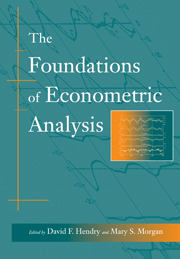Book contents
- Frontmatter
- Contents
- Preface
- Acknowledgements
- Introduction
- Bibliography
- I The Emerging Role of Econometrics in Economics
- II Early Time-Series Analysis
- III Applied Econometrics and the Identification Problem
- IV The Evolution of Statistical Thinking in Econometrics
- V Dynamic Models
- VI The Tinbergen Debate
- VII Structure and Simultaneity
- 38 Economic Interdependence and Statistical Analysis (in Studies in Mathematical Economics and Econometrics – In Memory of Henry Schultz, O. Lange et al. (eds.), University of Chicago Press, Chicago, 1942, pp. 135–50)
- 39 The Probability Approach in Econometrics (Supplement to Econometrica, vol. 12, 1944, pp. 12–17, 26–31, 33–9)
- 40 The Statistical Implications of a System of Simultaneous Equations (Econometrica, vol. 11, 1943, pp. 1–12)
- 41 Statistical Estimation of Economic Relationships (read to the International Statistical Conferences, Washington, 1947. Proceedings published as a supplement to Econometrica, vol. 17, 1949, pp. 9–21)
- VIII The Probabilistic Revolution
- IX Exogeneity
- Index
40 - The Statistical Implications of a System of Simultaneous Equations (Econometrica, vol. 11, 1943, pp. 1–12)
Published online by Cambridge University Press: 05 June 2012
- Frontmatter
- Contents
- Preface
- Acknowledgements
- Introduction
- Bibliography
- I The Emerging Role of Econometrics in Economics
- II Early Time-Series Analysis
- III Applied Econometrics and the Identification Problem
- IV The Evolution of Statistical Thinking in Econometrics
- V Dynamic Models
- VI The Tinbergen Debate
- VII Structure and Simultaneity
- 38 Economic Interdependence and Statistical Analysis (in Studies in Mathematical Economics and Econometrics – In Memory of Henry Schultz, O. Lange et al. (eds.), University of Chicago Press, Chicago, 1942, pp. 135–50)
- 39 The Probability Approach in Econometrics (Supplement to Econometrica, vol. 12, 1944, pp. 12–17, 26–31, 33–9)
- 40 The Statistical Implications of a System of Simultaneous Equations (Econometrica, vol. 11, 1943, pp. 1–12)
- 41 Statistical Estimation of Economic Relationships (read to the International Statistical Conferences, Washington, 1947. Proceedings published as a supplement to Econometrica, vol. 17, 1949, pp. 9–21)
- VIII The Probabilistic Revolution
- IX Exogeneity
- Index
Summary
Introduction
Measurement of parameters occurring in theoretical equation systems is one of the most important problems of econometrics. If our equations were exact in the observable economic variables involved, this problem would not be one of statistics, but a purely mathematical one of solving a certain system of ‘observational’ equations, having the parameters in question as unknowns. This might itself present complicated and interesting problems, such as the problem of whether or not there is a one-to-one correspondence between each system of values of the parameters and the corresponding set of all values of the variables satisfying the equation system. For example, if we have, simultaneously, a demand curve and a supply curve, the set of possible observations might be just one single intersection point, and knowing that only would not, in general, permit us to draw any inference regarding the slope of either curve.
Real statistical problems arise if the equations in question contain certain stochastical elements (‘unexplained residuals’), in addition to the variables that are given or directly observable. And some such element must, in fact, be present in any equation which shall be applicable to actual observations (unless the equation in question is a trivial identity). In other words, if we consider a set of related economic variables, it is, in general, not possible to express any one of the variables as an exact function of the other variables only.
- Type
- Chapter
- Information
- The Foundations of Econometric Analysis , pp. 454 - 463Publisher: Cambridge University PressPrint publication year: 1995
- 4
- Cited by

